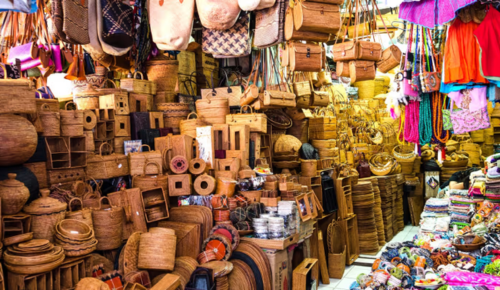Balinese Art & Handicrafts: Best Markets and Villages

Balinese art and handicrafts are a vibrant reflection of the island’s rich cultural heritage, blending Hindu influences, natural motifs, and skilled craftsmanship passed down through generations. From intricate silver jewelry and wood carvings to colorful textiles and paintings depicting mythical scenes, these creations embody Bali’s spiritual essence and artistic prowess. For travelers seeking authentic souvenirs or immersive experiences, exploring the island’s markets and villages is essential. Many visitors opt for customized Bali tour packages for art and handicraft exploration to navigate these spots efficiently, combining guided visits with cultural insights. This article delves into the best markets and villages, offering in-depth information to enhance your journey.
Best Markets for Balinese Art and Handicrafts
Bali’s markets are bustling hubs where local artisans showcase their work, often at affordable prices after some friendly bargaining. These venues not only provide shopping opportunities but also glimpses into daily Balinese life and traditions.
Ubud Art Market
Located in the heart of Ubud, Bali’s cultural capital, the Ubud Art Market (Pasar Seni Ubud) is arguably the most iconic spot for handicrafts. Situated across from the Ubud Royal Palace, this two-story market features stalls overflowing with items crafted by nearby villagers. Specialties include silk scarves, handmade woven bags, lightweight shirts, baskets, statues, and kites inspired by Balinese mythology. The market’s vibrant atmosphere, with vendors in traditional attire, makes it a sensory delight. Prices start high, but bargaining can reduce them by up to 50%. Open daily from 8 AM to 6 PM, it’s ideal for afternoon visits when the heat subsides. Depth note: Many pieces here incorporate natural dyes and motifs like the Barong (mythical lion) or Rangda (witch), symbolizing the eternal battle between good and evil in Balinese folklore.
Sukawati Art Market
As one of Bali’s oldest and largest art markets, Sukawati Art Market in Gianyar Regency offers an authentic, less touristy experience compared to Ubud. Established decades ago, it sources goods directly from local artists, featuring paintings, wooden sculptures, and handicrafts at competitive prices—often cheaper than in Kuta or Nusa Dua. Shop for colorful bed sheets with abstract art, aromatherapy incense, belts, bracelets, and clothing. The market spans multiple blocks, with upper levels dedicated to textiles. Located on Jalan Raya Sukawati, it’s about 30 minutes from Ubud. Tips: Arrive early (opens at 6 AM) to avoid crowds and practice your haggling skills, as vendors expect negotiation. In-depth: This market supports entire artisan families, preserving techniques like ikat weaving, where threads are dyed before being woven into intricate patterns.
Guwang Art Market
A hidden gem near Sukawati, Guwang Art Market (Pasar Seni Guwang) provides a calmer alternative with similar offerings but fewer visitors. Spread across three blocks in Guwang village, it specializes in beachwear, cotton shirts, sandals, jewelry, woodworking, and paintings. Prices are comparable to Sukawati, making it great for bulk buys. Open from 9 AM to 5 PM, its location on Jalan Raya Guwang allows easy pairing with a Sukawati visit. Depth insight: Art here often draws from Balinese ceremonies, with items like hand-painted masks used in dances, highlighting the island’s performing arts tradition.
Kuta Art Market
In the bustling tourist hub of Kuta, this market blends traditional Balinese souvenirs with modern brands like Quiksilver and Billabong. Known as Pasar Seni Kuta, it’s a one-stop shop for surfboard fridge magnets, keychains, colorful sarongs, fabrics, and Bali-themed t-shirts. While more commercialized, it retains cultural importance with local art stalls. Located on Jalan Bakung Sari, it’s convenient for beachgoers. Open until late (around 10 PM), bargaining is key. In-depth: Despite modernization, some vendors offer authentic batik fabrics, a resist-dyeing technique originating from Java but adapted in Bali with floral and animal designs.
Best Villages for Balinese Art and Handicrafts
Beyond markets, Bali’s artisan villages specialize in specific crafts, allowing visitors to witness creation processes and buy directly from makers for superior quality and authenticity.
Celuk Village
Renowned for silver and gold jewelry, Celuk in Gianyar Regency is a must-visit for intricate pieces like brooches, rings, bracelets, and ornaments. Artisans here use techniques handed down for centuries, often incorporating filigree work with Balinese motifs. Located near Ubud, many workshops offer classes where you can craft your own item. Depth: The village’s economy revolves around metallurgy, with families specializing in designs inspired by nature, such as lotus flowers symbolizing purity.
Mas Village
Near Ubud, Mas is the epicenter of wood carving, featuring divine sculptures at places like the Bali Wood Carving Center. Carvings blend naturalism and humanism, depicting gods, animals, and daily life with spiritual depth. Unlike tourist replicas, these are heirloom-quality. In-depth: Carvers use local woods like sandalwood or teak, infusing pieces with blessings during creation, reflecting Bali’s animist beliefs.
Batuan Village
Also in Gianyar, Batuan excels in paintings portraying local culture, including dancers, goddesses, and demons. Galleries here showcase works collected by dignitaries, supporting a tradition over 80 years old. Depth: The style is detailed and narrative, often using ink and acrylic to tell stories from the Ramayana epic.
Sidemen Village
In east Bali’s Karangasem Regency, Sidemen produces high-quality endek fabrics, hand-woven with natural dyes. Patterns can take weeks to complete, ensuring durability. In-depth: Weaving here is a communal activity, with looms in homes, preserving eco-friendly methods using plant-based colors.
Tips for Buying and Exploring
When shopping, always bargain politely—start at half the asking price and meet in the middle. Inspect for quality, as some items may be mass-produced. Visit during dry season (April-October) for better weather. For a seamless experience, consider customized Bali tour packages for art and handicraft exploration, which include transportation, guides, and village workshops. Respect local customs by dressing modestly and asking permission before photographing artisans.
In conclusion, Bali’s art and handicrafts scene offers endless discovery, from market bargains to village masterpieces. Whether you’re a collector or casual shopper, these destinations promise cultural enrichment and timeless keepsakes.
Also Read: 7-Day Bali Itinerary 2025: A First-Timer’s Travel Blueprint!




